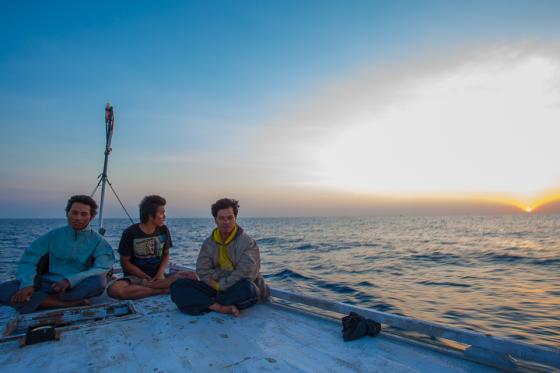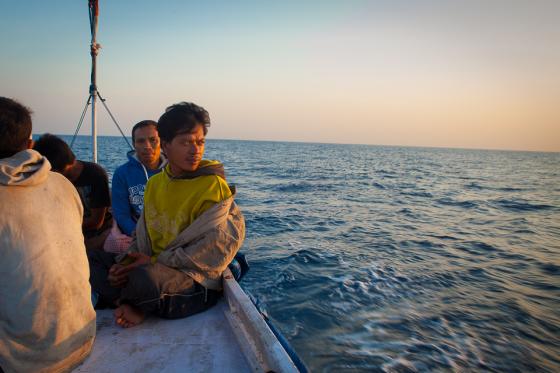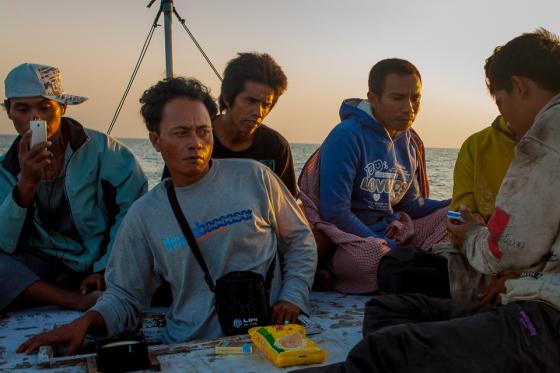Farewell Sapeken--A Nearly Sans-Photo Photo Essay
In the last three blogs we’ve been showing you tiny Sapeken island, the market & fishing hub for the eastern part of the Kangean Archipelago, north of Bali, east of Madura, in Indonesia.
Our entourage must get bored too easily. We decided we did not want to go depart Sapeken the way we’d come—a route that would involve discomfort while not letting us see anything new.
We’d learned that there are a few ways to get back from Sapeken without having to go back west through Madura. One is to wait till there’s a big traditional wooden sailing ship (now motor assisted) sailing with its holds full of fresh fish. We learned that one would depart early evening for north Bali & take about 12 hours to get there. Never mind that I’ve read more stories in the newspaper about these things going down than I’d care to think about & that a local terrified our local guides with his tale of his own passage on one so that our guides refused to go. The three Americans on our team agreed together to do this.
It was pitch black when we boarded. There were about six crewmembers & about a dozen other passengers, including a small Sapeken baby I saw being handed over the gap above the water. I called to the mother, “How old is he?” She shouted back, “One month! Don’t worry, this will make him a brave man!”
Just after stepping on the flat roof of the boat, we realized that the passenger deck below had already filled up. We’d spend the night on the roof.
If we encounter large waves, not to worry! The roof has a handrail fence around it—an impressive two inches tall! As we pull away from the docks, my friends & I remind each other, “Hey, this is not the high wave season. Should be smooth sailing.”
About half an hour later, in the pitch blackness, our eyes—now maxing out on night vision—perceive that we were shooting a course between two islands. We can also discern a lot of hills between these islands, & they were all moving toward us! A few moments later things get exciting.
I quickly hustle all my camera gear & my laptop into a large water-proof bag. Just in time. A couple minutes later a wave strikes our port bow covering the roof with saltwater spray.
We each hang on for dear life to the short handrail. With my free hand I frantically grip my gear bags. Occasionally you just can’t hold onto both. At those moments I grasp the gear & dig my elbows into the plywood ship’s roof & sliding from side to side.
One of my colleagues, sitting behind me, swears that the boat tilts 45 degrees at times. I’m not absolutely sure about that, but it's rolling at least a good 30 degrees. You start to slide to the right & gaze down into a big dip between waves, then before you slide off the right edge of the roof the ship begins to pitch back the other way. I quickly wear all the skin off both my elbows.
Eventually I figure out that—“Hey, I’ve been giving an all out effort to this madness for a couple hours now, & we’ve still got 10 hours to go. I’m not going to be able to sustain this all night!”
Fortunately, I then find a few inches of small rope hanging out from a knot used to secured a tarp on the side of the boat as a spray shield for the lower decks. In the darkness & fighting fatigue to concentrate, I try to remember how to form a bowline knot to secure our bags. It works—at least for now, though I tell myself, “There’s no way that’s going to hold all night!” Something gonna go overboard tonight—better gear—however expensive—than people.
We stay awake until very late at night—the wave action exciting enough to keep us alert despite blinding fatigue. It’s a really good thing that it's so dark. Between our fatigue & the darkness, we can barely discern the impressive wave action around us. If we were able to see it on a clear day, we'd probably despair & give up hope.
We see the crew climb forward on the pitching deck & over mountains of thin Styrofoam coolers filled with fish. In the chaos they wrestle the main sail into place. The wind was howling, & at times it seems the sail must rip or the mast break. But if the sail means we’ll get through these high seas to Bali a bit faster, we were all for it.
I’ve led training in intercultural skills many times, & when working with North Americans I’ve typically run participants through an ethnographic survey of American values to help them become aware of their own assumptions before they go indiscriminately judging everyone else’s.
That night—hanging on for dear life to the top of that traditional sailing boat, I discover a very deeply held American value that I’ve never seen recorded in the literature. My intern is the first to demonstrate it, but I do too. Having been out in the blistering equatorial sun all day, Kenny & I had been "good doobies" & had thoroughly hydrated ourselves.
Now, if you can vividly picture what it looks like when everything is in varying shades of black, then picture this. Kenny turns to one of the crewmen & asks, “Where’s the bathroom?” He needs to relieve his bladder. An empty Aqua bottle is handed forward, which then promptly blows overboard.
The crewmember informs us that these boats make no provision for such an eventuality! He finally admits that if you really have to go, there was a place on the starboard side just forward of the ship’s roof where--by standing on the squishy tops of Styrofoam fish coolers, bracing your right knee behind a vertical 2x2 board & holding on to the two-inch high hand rail with your right hand--a person can conceivably relieve themselves without dying. Kenny is really hurting, so he risks it. When he crawls back up to a safer position on the roof he tells me that he’s rarely done a workout that tired him as much as what he'd just done. Then I have to go.
While I attempting this intricate exercise, the ship occasionally takes a huge wave on its port bow & roles hard to the right—until it catches a similar wave on the starboard bow & jerks violently back to the left. I’m standing there facing the dark ocean & suddenly feel myself being pitched harshly toward the . . . uh . . . big drink before me. It is all one can do to hold fast to that little handhold & not plunge overboard.
So, what’s this newly-discovered American value that all the ethnographers missed? It’s this: the American male (at least) would rather face certain death rather than sit all night in his wet diaper. I don’t know why this is; it’s undoubtedly a vital part of our socialization.
Is Sapeken socialization different from ours? (Yes!) Is this why no one ever gave a thought to providing a privy on these boats? A subject for the next ethnographer’s PhD dissertation!
Eventually Kenny becomes convinced that if he stays on the roof, he’ll be lost overboard. So, he drops through the pilot’s hatch & insists on a place to stretch out. Somehow they wedge him between others—in the only place no other passenger wants. That lone spot has no side. A broken board has left a sizable hole through which a passenger can easily fall overboard. Kenny figures out how to wedge one foot against his neighbor’s piece of bulkhead & somehow manages to get some sleep.
Everyone else down there sleeps too, but before Kenny dozes off he witnesses some drug being liberally imbibed—even by the baby.
My colleague Glen stays on the roof with me. He's the smartest one among us—tying his sarong around a sail support post. I joke that if the ship capsizes he’d still be tied to that post when Robert Ballard finds the wreck. He watchs me sliding back & forth toward the abyss & just shakes his head.
At some point in the night I do get some sleep—my hand instinctively grasping at the rail when my weary brain detects a heavy pitch.
Finally, about 5 AM the eastern skies begin to lighten up. Before long we discern Bali’s Gunung Agung volcano to the southeast.
A few of the crewmembers who’d stay atop all night are now visible, and the seas still enough for me to get my cameras out again. Amazingly my gear bags are all still secured to the small rail by my bowline knot.
All we lost overboard was the head to my Sapeken walking cane—made by the village craftsman.
Kenny comes up to on deck to see if we were still alive.
He finds Glen still strapped to the sail support by his sarong, & me leaning on raw elbows. Kenny’s probably the first tourist since the 1950s to see Bali for the first time not from an airplane window, nor from a ferry, but from a traditional sail ship & approaching from the north.
The Sapeken crewmen—who easily chill—welcome the first rays of the new day’s sun.
Soon the whole compliment of crewmen are on deck, now picking up cell phone signals, & contacting their awaiting wives & girlfriends to tell them that they’d survived another voyage.
We settle up with the captain, in the grey sweatshirt, at $5.50 passage per person—deck class. The captain asks us what we think of last night’s waves? All three of us, aware that we were in the presence of hardened sailors, hold our tongues. “Finally, someone replies to him, “You know these waters! What do you think of the waves?”
A smile slowly spreads across his face, & he whispers, “Last night . . . we saw some pretty big waves!”
. . . . . . . . . . . .
A week in Indonesia could do wonders for your photo portfolio. And this year it’s easier to arrange than ever before. Check out our Java-Bali Photo Tour with Matt Brandon of the digitaltrekker.com. Then reserve your spot here at our one-time-only introductory price! Be sure to make the most of it by also getting in on the Borobudur & Jogjakarta extension tour. We look forward to shooting Java & Bali together!




